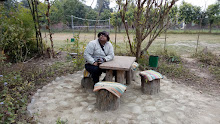Digera muricata (L.) Mart.
False Amaranth !!
BOTANICAL NAME: Digera muricata (L.) Mart.
FAMILY NAME: Amaranthceae
SYNONYMOUS NAMES: Achyranthes alternifolia L.
Achyranthes muricata L.
Digera alternifolia (L.) Aschers.
Digera arvensis Forssk.
COMMON NAME(s): Lesua in Hindi
PART USED: Fruits, Whole Plant.
HABITAT: cultivation and waste places.
DISTRIBUTION:Widespread in southern Asia from tropical Arabia and the Yemen to Afghanistan, India, Ceylon, Malaysia and Indonesia. Also in S., C. and E. tropical Africa and Madagascar. Everywhere as a weed of cultivation and waste places, and occurring as such in Pakistan up to an altitude of at least 1500 m.
DESCRIPTION:>>Annual herb, (15-) 20-50 (-70) cm, simple or with ascending branches from near the base; stem and branches glabrous or very sparingly pilose, with pale ridges.
>>Leaf-blade narrowly linear to broadly ovate or rarely subrotund, (12-) 20-60 (-90) x (2-) 6-30 (-50) mm, glabrous or the petiole and principal veins of the lower surface of the leaf spreading-hairy, acute or acuminate at the apex, longly or (in broader-leaved forms) rapidly narrowed to the base; petiole slender, in the lower leaves up to c. 5 cm, shortening in the upper leaves.
>>Flowers glabrous, white tinged with pink to carmine or red, usually becoming greenish-white in fruit, in long and slender or shorter and denser axillary racemes, long-pedunculate, up to c. 30 cm long, laxer below; peduncles slender, the lower up to c. 14 cm in length, both they and the inflorescence axis glabrous or sparingly spreading-hairy; bracts persistent, deltoid-lanceolate, acuminate, 1-2.75 mm, glabrous, membranous with a green or brownish percurrent midrib, each subtending a very shortly pedunculate partial inflorescence of 3 flowers. Central flower fertile, the 2 membranous, navicular outer perianth segments c. 3-4.5 mm long, oval or oblong, 7-12-nerved (in Asia), acute; the 2-3 inner segments slightly shorter, more delicate, blunt or erose, 1-3-nerved, hyaline, with a darker central vitta; stamens sub-equalling or shorter than the style; style c. 1.5-4 mm, the 2 stigmas finally recurved. Lateral flowers appressed, 1-bracteolate, bracteoles similar in form to the bract, these flowers much reduced and increasingly so in the upper part of the spike (sometimes absent there), modified into accrescent, antler-shaped scales, these scales with the lateral lobes narrow (in Asia) to broad and wing-like.
>>Fruit subglobose, slightly compressed, 2-2.5 mm, bluntly keeled along each side, surmounted by a thick rim or a corona of short, firm processes furnished throughout with verrucae or ridges, style persistent.
FLOWERING SEASON: August-September.
PLANT CHEMICAL CONSTITUENTSAnalysis of various fractions of the D. muricata indicated the presence of flavonoids, alkaloids, terpenoids, saponins, coumarins,
tannins, cardiac glycosides and anthraquinones.
USES & BENEFITS>In India, the young leaves and shoots of False Amaranth are made into curries, or the entire plant is boiled and seasoned.
>Though almost all of its parts are used in traditional systems of
medicines, leaves, roots and shoots are the most important parts which are used medicinally.
>wide numbers of phytochemical constituents have been isolated from the plant which possesses activities like antibacterial, antifungal, diuretic, laxative, Free radical scavengic activity, anthelmintic, and various other important medicinal properties.
>The crushed plant is used as mild astringent in bowel complaints.
>Flowers and seeds used in the treatment of urinary discharges.
SOURCES:>>>> http://www.efloras.org/florataxon.aspx?flora_id=5&taxon_id=250064265
>>>>http://www.flowersofindia.net/catalog/slides/False%20Amaranth.html
>>>>http://globalresearchonline.net/journalcontents/v20-1/19.pdf
>>>>http://indiabiodiversity.org/species/show/229563
>>>>http://connection.ebscohost.com/c/articles/90613185/review-digera-muricata-l-mart-great-versatile-medicinal-plant
>>>>https://sites.google.com/site/efloraofindia/species/a---l/a/amaranthaceae/digera/digera-muricata
>>>>http://books.google.co.in/books?id=6jrlyOPfr24C&pg=PA286&lpg=PA286&dq=digera+muricata&source=bl&ots=DqxgqQSuV-&sig=XHoUQuHJd1qGLft6BteyjMV0fco&hl=en&sa=X&ei=cH9BVMnsC86NuATesoKIBw&sqi=2&ved=0CFoQ6AEwDA#v=onepage&q=digera%20muricata&f=false




%5D+ban+tulsi.JPG)







